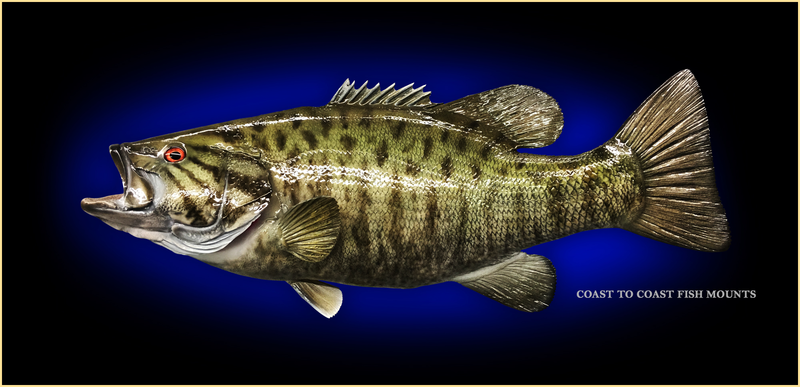Fiberglass Mounts: Keeping Trophies and Releasing Fish
Proudly displaying mounted fish on the wall is a common practice for anglers. Fish can be memorable for all sorts of reasons. Maybe it was someone's first fish, biggest fish, or prettiest fish. Maybe a father caught it with his daughter and wants to remember their trip. Whatever the reason, there are fish that people want to remember, and getting a fish mounted is one way to do that.
At the same time, many people practice catch-and-release fishing. If that's the case, that memorable fish is probably back in its home water, never destined to end up on a basement wall for all to enjoy. For these folks, who want to release their catch but also keep a trophy, fiberglass mounts are a good solution.
Fiberglass fish mount (smallmouth bass) done by Joe Pitruzzello, Northeast Taxidermy Studios, Middletown, CT
Traditional fish taxidermy
Traditionally, mounts have been made using the actual fish. In this process, the skin, with head and tail still attached, is removed from the rest of the body. The eye is removed and the inside of the skin cleaned out. This leaves a hollow, fish-shaped skin.
The skin, head, and tail are preserved using chemicals, and then the hollow cavity is filled in, often with sawdust. The fins are carefully dried, so as not to allow shriveling or cracking, and the rest of the skin also dries slowly. Add a glass eye, and some paint to bring the lively color back into the skin, and you've got yourself a fish mount.
Downsides to traditional
While the natural taxidermy method is still used and works, there are some downsides.
First of all, it requires a dead fish. Although there's nothing wrong with keeping a fish within regulations, it won't produce the nicely-sliced fillets of a non-taxidermy catch. Anglers may not opt to kill a fish that they can't fillet up into a delicious meal. Additionally, some fish may not be legal to keep anyway.
Some fish also just aren't cut out for traditional mounts. For example, greasy, thin-skinned fish like trout and salmon are tricky. The skin can be finicky, and is often so thin that some fillers will show through, requiring special techniques.
Another downside is the need to keep the fish well-preserved between the net and the workshop. Letting a fish dry out too much or get too warm can ruin the possibility of a mount. While the effort to preserve a fish is worth it for some people, most would probably rather not have to worry about keeping a trophy in prime condition while they continue to fish.
Fiberglass fish mount (Arctic grayling) done by Joe Pitruzzello, Northeast Taxidermy Studios, Middletown, CT
Fiberglass mounts
These days, more and more people are making the switch to fiberglass mounts. For many, these mounts are the perfect solution to the downsides of natural taxidermy.
Fiberglass mounts are essentially just lifelike replicas of previously-caught fish. To make a fiberglass mount, a taxidermist uses as much information as possible from the angler to accurately recreate a catch. This includes the length, girth, and weight of the fish if known. A clear photo is also key, so the coloration can be accurately reproduced.
The fiberglass replica is sized based on the specific measurements provided by the fisherman, and then painted to match photos. This means that fiberglass mounts, though not made from the actual skin of the fish, are still unique to the individual trophy.
Fiberglass mounts are a great alternative to real fish mounts for all sorts of reasons. First and foremost, all the hassle of dealing with a real fish is gone. No need to worry about preserving a dead fish, and there's no risk of skin shrinkage or cracked fins. The chance of a mount deteriorating or developing an odor is also eliminated.
Additionally, species with thin or greasy skin like trout can be mounted just as easily as other species, unlike in traditional methods. Saltwater fish are also known for being tricky, so fiberglass mounts are a great option for them, too. These replicas are also ideal for anyone who wants to eat their catch or release the fish, as well as fish that aren't legal to keep. Since most anglers already take nice photos of their best catches, it's not much more work than the usual routine to get all the info needed for a fiberglass replica.
To top it off, most fiberglass mounts are comparable in price to traditional methods. So, next time you're stuck between wanting a trophy for the wall and not wanting all the downsides that come with it, consider getting a replica made.


